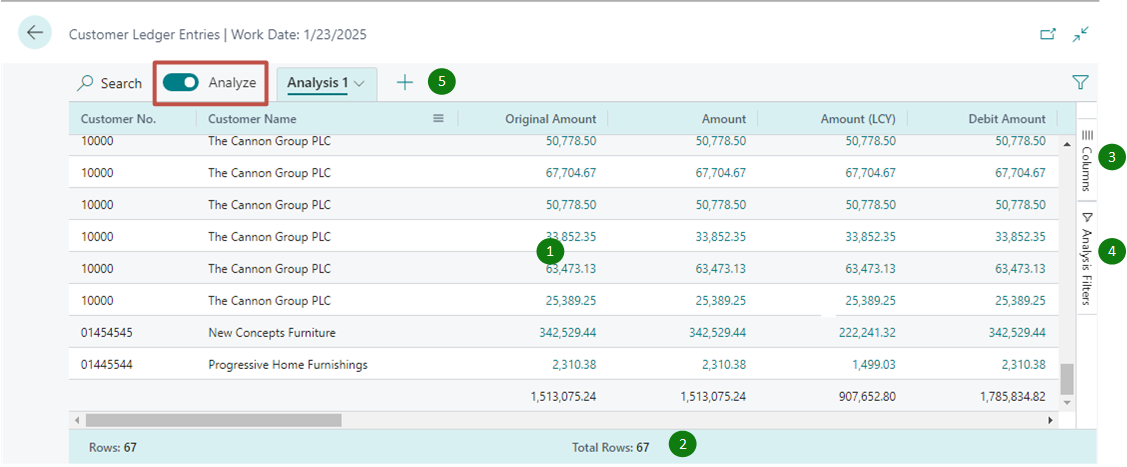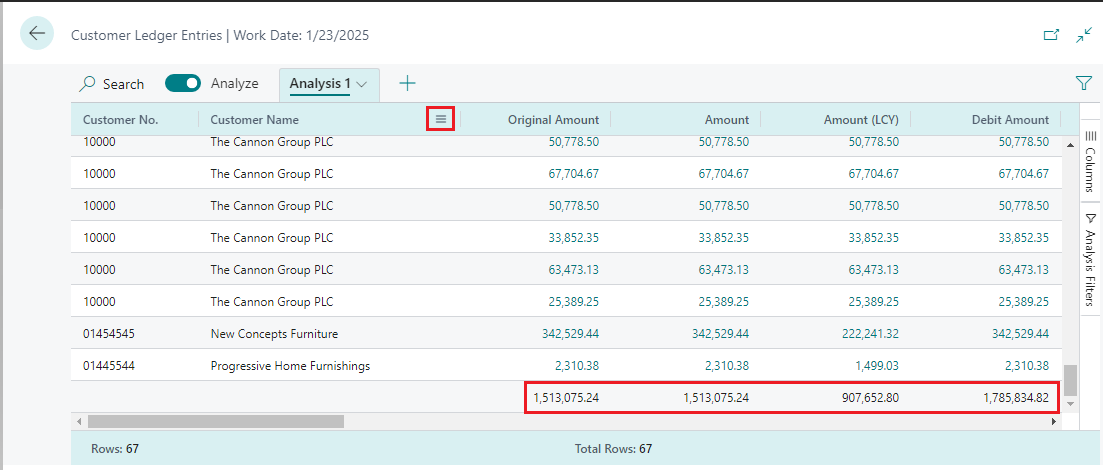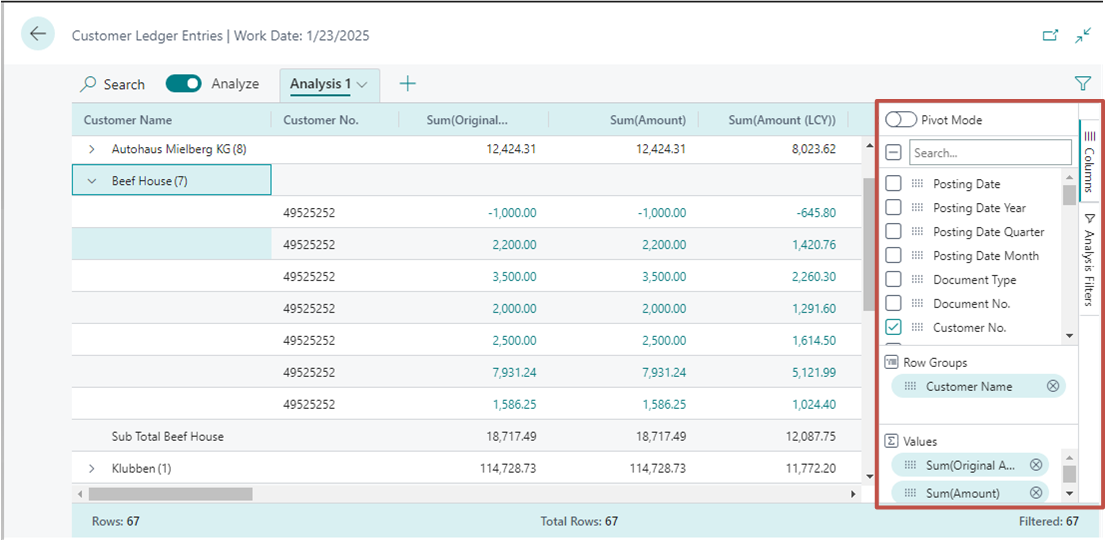Analyze, group, and pivot data on list pages using data analysis mode
End users and data analysts can analyze data from list pages directly in the client without the need to open the page in Excel or run a report.
The ability to analyze data directly in list pages raises the bar for what you can do without having to switch applications, while still allowing customers and partners to do more in report objects, Excel, Power BI, or other data analysis applications.
The data analysis mode enables you to analyze data directly from the page, without having to run a report or switch to another application like Excel. It provides an interactive and versatile way to calculate, summarize, and examine data. Instead of running reports using different options and filters, you can add multiple tabs that represent different tasks or views on the data. Examples could be My customers, Follow up items, Recently added vendors, Sales statistics, or any other view you can imagine.
A good thing about the data analysis mode is that it doesn't change any of the underlying data of the list page. And it doesn't change the layout of the page when it's not in data analysis mode. So the best way to learn about what you can do in the data analysis mode is to try things out.
The data analysis mode is currently in preview, which means that an administrator must turn it on before you can use it. If you're an administrator and you want to turn on data analysis mode, go to the Feature Management page and enable Feature Preview: Analysis mode, quickly analyze data directly in Business Central.
To get started with Analysis mode, follow these steps:
Open the list page.
For example, to work with Customer Ledger Entries, select the Search for Page icon (Alt+Q), enter customer ledger entries, and then choose the related link.
In the action bar at the top of the page, turn on the Analyze toggle switch.
Data analysis mode opens the data in an experience that's optimized for data analysis. While in data analysis mode, the normal action bar is replaced with a special data analysis mode bar. The figure after these steps illustrates the different areas of a page in the data analysis mode.
Use the different areas to manipulate, summarize and analyze data.
When you want to exit the analyze mode, turn off the Analyze toggle switch.
The analysis tabs that you've added remain until you delete them. So if you return to the data analysis mode again, you see them exactly as you left them.
The data shown in analysis mode is controlled by the filters or views set on the list page. This allows you to pre-filter data before entering analysis mode.
In the data analysis mode, the page is divided into two areas:
The main area, which consists of the data area (marked 1 in the image), summary bar (2), and tabs bar (5)
The data manipulation area, which consists of two panes: columns (3) and analysis filters (4)
Data area
The data area (marked 1 in the image) is where the rows and columns of the list page are shown and data is summarized. The data area provides a versatile way to control of the layout of columns and a quick way to get a summary of the data. For columns that contain numeric values, the sum of all values in the column is shown in a last row, unless you've defined row groups. In this case, the sums appear as a subtotal for the groups.
To move a column, select it and drag it to where it makes the most sense in your analysis.
Right-click the column or hover over it and select the menu icon to access several actions that you can do on columns. For example:
To pin a column to the left or right of the data area so that it doesn't move off the screen when you scroll, select the menu icon > Pin column > Pin left the column part.
Define data filters directly on the column definition instead of going to the Analysis Filters panes. You can still peek in on details about related data and for each line, and open the card to learn more about a given entity.
Use the data area to interact with the data. For columns that contain numeric, summable values, you can get descriptive statistics on a set of fields by marking them. The statistics appear in the summary bar (2) along the bottom of the page.
Export data in Excel or CSV format. Right-click on the data area or a selection of cells to export.
Summary bar
The summary bar (marked 2 in the image) is along the bottom of the page and displays statistics about the data in the list. As you interact with columns whose values can be summed, like selecting multiple rows in a column that displays amounts, the data updates.
This list describes the different numbers that are shown in the totals area:
Rows - The number of selected rows as a part of the total number of available rows.
Total rows - The numbers of rows in the unfiltered list.
Filtered - The number of rows displayed as a result of the filters applied to the list.
Average - The average value in all the selected summable fields.
Count - The number of selected rows.
Min - The minimum value in all the selected summable fields.
Max - The maximum value in all the selected summable fields.
Sum - The sum total of all the values in the selected summable fields.
Columns
The Columns pane (marked 3 in the earlier image) is one of two panes that work together to define your analysis. The other area is the Analysis filters pane. The Columns pane is used to summarize the data. Use the Columns pane to define which columns should be included in the analysis.
Search/check or clear all boxes - Search for columns. Select the check box to select/clear all columns.
Check boxes - This area includes a check box for each field in the list's source table. Use this area to change what columns are shown in the list. Select a check box to show column for the field on the page; clear the check box to hide the column.
Row groups - Use this area to group and sum data by one or more fields. You can only include non-numeric fields, like text, date and time fields. Row groups are used often in pivot mode.
Values - Use this area to specify fields that you want a sum total for. You can only include fields that contain numbers that can be added together; for example, not text, date, or time fields.
To move a field from one area to another, select the grab icon next to the column in the list above and drag it into the target area. You're prevented from moving a field into an area where's it's not allowed.
Analysis filters
The Analysis filters pane (marked 4 in the earlier image) lets you set further data filters on columns to limit the entries in the list. Set filters on columns to limit the entries in the list and subsequent sums to only those entries you're interested in based on a criteria you define. For example, suppose you're only interested in data for a specific customer or sales orders that exceed a specific amount. To set a filter, select the column, choose the comparison operation from the list (like Equals or Starts with), then enter the value.
The extra filters only apply to the current analysis tab. This allows you to define exactly the extra data filters that are needed for a specific analysis.
Tabs
The tabs area (marked 5 in the earlier image) at the top lets you create different configurations (columns and analysis filters) on separate tabs, where you can manipulate data on the tabs independently of each other. There's always at least one tab, called Analysis 1 by default. Adding more tabs is beneficial for saving frequently used analysis configurations on a dataset. For example, you might have tabs for analyzing data in the pivot mode, and other tabs that filter to a subset of rows. Some tabs might show a detailed view with many columns, and others only display a few key columns.
Here's some pointers on working with multiple analysis tabs:
To add a new tab, select the large plus sign (+) next to the last analysis tab.
Select the down arrowhead on a tab to access a list of actions you can do on a tab, like rename, duplicate, delete, and move.
Delete deletes the tab you currently have open. Delete All deletes all tabs that you've added, except the default Analysis 1 tab.
You can't completely remove the Analysis 1, but you can rename it by using the Rename action and clear the changes you've made by using Delete or Delete All.
The analysis tabs that you've added and configured remain until you delete them. So if you return to the data analysis mode again, you see them exactly as you left them.
The tabs that you set up are only visible to you. Other users only see tabs they've set up.
You can copy analysis tabs. Copying can be useful if you want to experiment with changing a tab without changing the original. It's also useful if you want to create different variations of the same analysis.
Pivot mode
You can use pivot mode to analyze large amount of numerical data, subtotaling data by categories and subcategories. The pivot mode is like pivot tables in Microsoft Excel.
To turn pivot mode on and off, slide the Pivot mode switch in the Columns pane. When you turn on the pivot mode, the Column labels area appears in the pane. Use the Column labels area to group sum totals for rows into categories. Fields that you add to the Column labels area show as columns in the data area.
Building out the data analysis in pivot mode involves moving fields into the three areas: Row groups, Columns labels, and Values.
Columns that only have a few possible values are the best candidates for using in column Values.
Limitations
The analysis view currently has a limit of 100,000 rows. If you exceed this limit, you get a message telling you so. To work around this limitation, the set filters on the page before you switch to data analysis mode, if it's possible. Maybe you want to analyze a certain group of customers or maybe you want data from the current year only. You can also choose a predefined view if it would work for your analysis.




